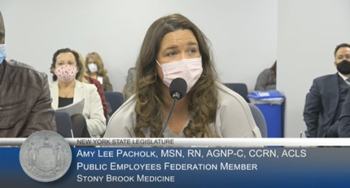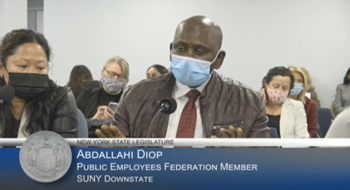
As the saying goes, “Don’t make the same mistake twice.”
That’s why PEF nurses appeared before the New York State Assembly Standing Committee on Health, Higher Education and Labor last month to highlight the impacts of the COVID-19 pandemic on the health care sector and the health care workforce.
Short staffing and hazard pay
At the top of the list: the pandemic exacerbated the long-standing issue of short staffing.
“We were short staffed before the pandemic, now it’s even worse,” said Amy Lee Pacholk, a nurse at Stony Brook University Medical Center and a professor of adult health. “My unit used to have 70 FTEs (Full-Time Equivalent staff). Now we have 55. That disparity is huge.”
Pacholk testified that state positions are down tremendously, with 7,000 fewer jobs than in 2019 and 16,000 fewer than 2011.
 “People are leaving for a variety of reasons,” Pacholk said. “Staffs are hemorrhaging. There is mental fatigue and trauma. There is only so much you can take as a human. I love my job. People come to me when they’re dying and I love to save them.”
“People are leaving for a variety of reasons,” Pacholk said. “Staffs are hemorrhaging. There is mental fatigue and trauma. There is only so much you can take as a human. I love my job. People come to me when they’re dying and I love to save them.”
Adding to the burnout is mandated overtime, Pacholk said.
“You plan to come in for eight hours and then you are stuck there for 16,” said Pacholk. “A colleague at a psychiatric center upstate, his staff are being mandated for 24 hours. Imagine you have a family at home. What does that mean for your children? What does the mean for your nursing license – if you leave, they can write you up for abandoning your patients. It happens all the time, every week, every day.”
In 2020, state workers put in 19 million hours of overtime – costing the state $850 million.
PEF posed the question: instead of spending $850 million on overtime, how many staff could be hired with that money? How could the resources be better used to improve continuity and quality of care?
Pacholk said nurses are appreciative of the nurse staffing committee law passed this year, but some of the fine print is obtuse, allowing hospital management to set the ratios if nothing has been determined before January 1, 2022. Hospitals setting their own staffing ratios is already the problem, Pacholk said.
“The law should expand to include all other facilities,” she added. “OMH, OPWDD, OCFS, DOCCS, they all rely heavily on mandated overtime.”
Fellow PEF member and SUNY Downstate transplant nurse, Abdallahi Diop, joined Pacholk before the committee panel and talked about the lack of recognition for health care workers on the frontlines of the pandemic.
Diop said his facility served as the only COVID-only hospital downstate and health care workers reported to work not knowing a lot about COVID-19 as the pandemic first gained a footing in New York.
“We decided to go in and to do the best we can to save lives,” he said. “At the end of the day, there was nothing. There has never been a thank you for putting themselves and their family at risk. It’s a shame. The state should take action by giving these people hazard pay for all that they do.”
PEF has developed legislation to attract and retain nurses and help to develop a pipeline for new people to enter the profession. The “Nurse Employment, Enhancement and Dignity Act” (N.E.E.D.) would provide hazard pay, a loan forgiveness program, an annual tax credit and preferred entry into SUNY and CUNY schools for state-employed nurses.
“The state has already received more than $12 billion in unfettered federal support through the American Relief Plan,” the hearing testimony states. “Unfortunately, few of these resources have been dedicated to addressing the ongoing staffing shortage.”
Outsourcing and agency nurses
The use of “agency” or contract nurses rose exponentially during the pandemic as the need for skilled health care professionals to fill staffing gaps rose. While nurses were grateful for the help, that help also brought pitfalls.
“It’s a Catch-22,” Pacholk said. “I’m grateful for them when we are short staffed, but if you have 10 nurses, two might have my skill set, but most don’t have the skills they need to take care of our patients. You give them the easiest jobs on purpose.”
To meet pandemic need, New York employed agency nurses from in and outside the state. They were paid more and had fewer responsibilities.
“Many of these workers come from out of state, have no connection to the facility or the patients and earn $250 per hour for their work,” PEF President Wayne Spence wrote in testimony submitted to the Assembly. “They do not maintain caseloads and often demand the most favorable shifts before on-boarding. As you can imagine, it is incredibly demoralizing for the state’s nurses to see their co-workers earning multiples of their hourly overtime as they are repeatedly asked to work more and more.”
PEF maintains the overreliance on overtime to meet long-term staffing needs has broader implications on the culture of work at the state’s hospitals, mental health facilities, and homes for the developmentally disabled. It also hampers the ability of agencies to attract and retain talent, especially highly-trained workers in high demand fields (i.e., nurses, psychiatrics, etc.).
Improve pension benefit
 Salary and pension are two things once synonymous with a good state job, but salaries have not kept pace with the industry.
Salary and pension are two things once synonymous with a good state job, but salaries have not kept pace with the industry.
“Salaries are $10,000 lower,” Diop said. “We believe Civil Service should undertake an analysis of the salary grade system and make recommendations.”
State jobs were once sought-after.
“Public service was valued and public servants were respected,” Spence’s written testimony stated. “While our members love the work they do, they are telling us that they can no longer afford to work for the state – the hours, the low pay, the marginal pension benefits. They see the agency nurses in their facilities and they know that they are not being paid at market rate.”
PEF believes reviewing and reforming salary grades and improving the pension plan will entice more people to enter state employment and reduce staffing shortages.
“Now is the time to right size the benefits of the pension plan so that it can serve as an additional inducement to attract and retain sorely needed professional staff,” PEF wrote.
To view Pacholk and Diop’s testifying, click here (starting at 2:19:00). To view the full submitted testimony, click here.

